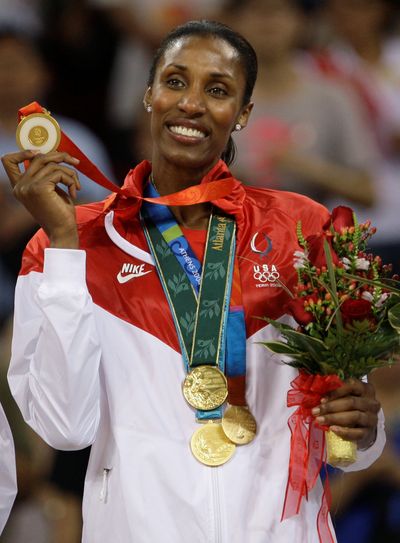Leslie paved way for current stars

BEIJING – The next time some fool argues that Title IX should be rewritten, just show them the highlights of the U.S. women’s basketball team at this Olympics, and of Lisa Leslie in particular. Twelve years of playing for her country, never a single loss, and four gold medals. Think she was worth the funding?
You could hear Leslie coming down the hallway of the Olympic basketball arena from the noise of the gold medals clanking around her neck. They dangled from a medley of ribbons, rattling like a woman wearing too much jewelry as she walked. She had come to Beijing with a snapshot in her mind of how she wanted to look when she ended her Olympic career, and had packed her three previous medallions, from Atlanta, Sydney and Athens. “My vision was to have four gold medals around my neck,” she said. Now that she had made the picture a reality, with the USA’s 92-65 rout of Australia, it didn’t just look great, it sounded great.
Leslie’s final numerical contribution will be marked down in the record books as 14 points, seven rebounds and two blocked shots. But that doesn’t begin to describe what the 36-year-old towering centerpiece of the U.S. women’s team has given to the program over the years, and especially in this one, as she returned from a 2007 maternity leave and shepherded a brilliant new brigade of young American players in her final season of international play. America’s ultimate Title IX baby did a little of everything. She hit whirlaround jumpers, including her first five shots of the game, snagged rebounds out of the air, smothered Australia’s star center Lauren Jackson, and basically altered everything in her circumference.
“I’m exhausted,” she said. “It’s been hard fought to get all these medals, no lie,” she said.
But most important, Leslie set the tone for the team every moment she was on the floor – and there were times when she literally was on the floor, mopping it with her body chasing loose balls. “She’s in on every shot,” said U.S. assistant coach Dawn Staley, her former teammate. “Lisa sets the example of how your best player has to be your hardest worker.”
It was the first time in four Olympics that Leslie wasn’t the U.S. leading scorer, but she delivered a totally characteristic display of basketball-as-ethic, that will be her real legacy. Her bequest to the United States is a class of superbly talented but also dedicated athletes led by the 22-year-old Candace Parker (14 points) and Sylvia Fowles (13 points). “It’s about giving back what you learn,” Parker said. Based on their overwhelming displays throughout the Olympic tournament, they will have every chance of winning four more gold medals. “Showed ’em the way,” Leslie said. “I’m handing it over to ’em. They have to keep it going now.”
When Leslie won her first gold medal in ’96 in Atlanta – with teammates like Sheryl Swoopes and Cynthia Cooper, who helped her give credibility to the WNBA – Parker was 10 years old. No one back then believed that women would be able to play at the rim consistently. A dozen years later the girls who idolized Leslie have grown into arguably the greatest class of female players, led by Parker and Fowles, both of whom can dunk with something approaching ease, and both of whom clearly pay homage to her, and not just as ballplayers. “It’s way she’s carried herself off the court,” Fowles said. “As a woman, a teacher, a listener, all of that.”